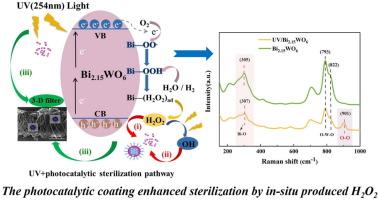Important contributions of in-situ produced H2O2 during photocatalytic sterilization of air by self-doped Bi2.15WO6
IF 8.1
1区 工程技术
Q1 ENGINEERING, CHEMICAL
引用次数: 0
Abstract
Photocatalytic generation of oxidative free radicals is an effective method to eliminate viruses and bacteria in air. Nevertheless, the underlying mechanisms governing the gas-phase sterilization remain unclear. In this study, the self-doped Bi2.15WO6 was synthesized to prepare the Bi2.15WO6 coating. In the presence of Bi2.15WO6 coating, the average logarithmic degradation efficiencies (LDEs) are 3.82 and 3.07 for E. coli and S. aureus, respectively under UV illumination for 12.9 s, indicating its desirable sterilization efficiencies. In addition, the sterilization rates of E. coli and S. aureus slightly decrease by 3 % and 6 % after 30-repeated cycles, indicating the high stability of this catalytic coating. The 2,7-dichlorofluorescein (DCF) fluorescence experiments and SEM analysis indicate that reactive oxygen species (ROS) produced by Bi2.15WO6 have effectively destroyed cell structure to achieve the complete inactivation. The N,N-diethyl-p-phenylenediamine sulfate (DPD) and radical trapping experiments further reveal that H2O2 is the primary oxidizing species, and its yield is linearly proportional to the LDE values. The produced H2O2 is further decomposed to •OH under UV irradiation to kill bacteria. Raman analysis confirms the presence of the intermediate species of surface ≡Bi-OO•superoxo and/or ≡Bi-OOH peroxo groups on Bi2.15WO6, which are the precursors of H2O2. In addition, the 3-D filter facilitates sterilization by the Bi2.15WO6 in that it prolongs the duration of free radical via physically intercepting bioaerosols, thus apparently improving the degradation rate. This study provides new insights on the sterilization mechanism involved in the gas-phase photocatalytic processes.

求助全文
约1分钟内获得全文
求助全文
来源期刊

Separation and Purification Technology
工程技术-工程:化工
CiteScore
14.00
自引率
12.80%
发文量
2347
审稿时长
43 days
期刊介绍:
Separation and Purification Technology is a premier journal committed to sharing innovative methods for separation and purification in chemical and environmental engineering, encompassing both homogeneous solutions and heterogeneous mixtures. Our scope includes the separation and/or purification of liquids, vapors, and gases, as well as carbon capture and separation techniques. However, it's important to note that methods solely intended for analytical purposes are not within the scope of the journal. Additionally, disciplines such as soil science, polymer science, and metallurgy fall outside the purview of Separation and Purification Technology. Join us in advancing the field of separation and purification methods for sustainable solutions in chemical and environmental engineering.
 求助内容:
求助内容: 应助结果提醒方式:
应助结果提醒方式:


